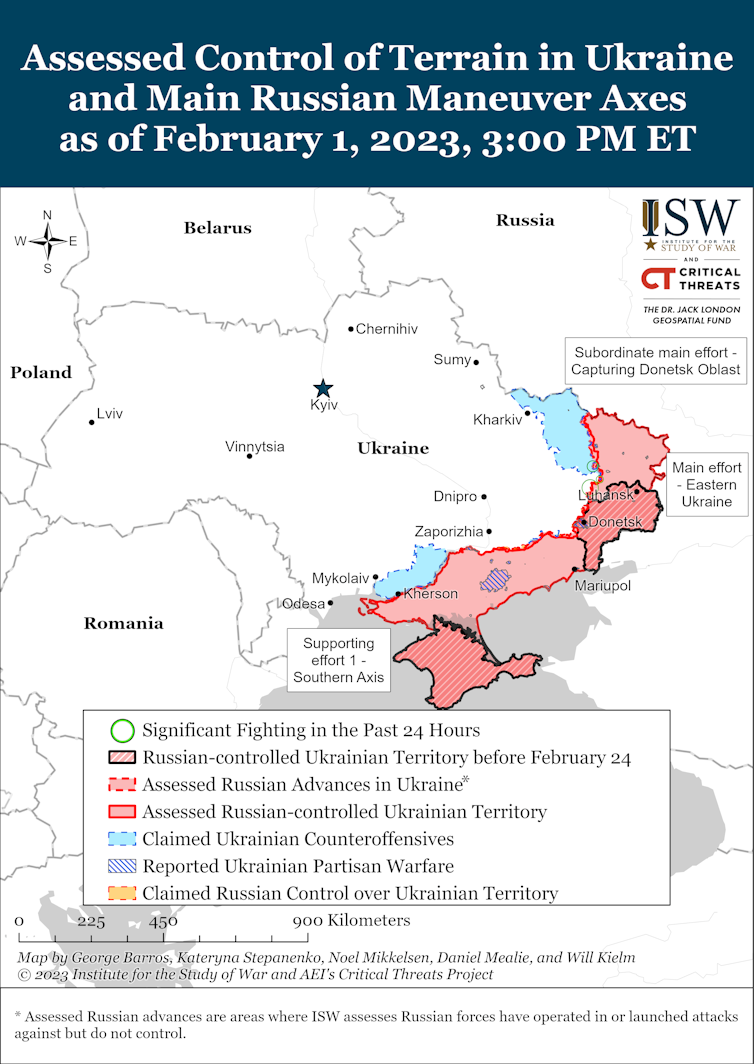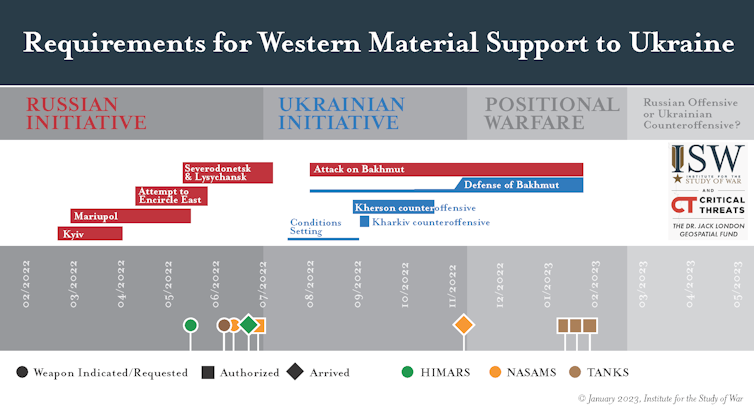The latest dispatches from the Institute for the Study of War make for sobering reading. After a few months in which the initiative on the battlefield was generally considered to be firmly with Ukraine, the pendulum appears as if it could be swinging gradually back Russia’s way.
This is by no means to say that Russia is suddenly “winning the war”, but since early December, with heavy fighting continuing around the city of Bakhmut in the Donbas region, Russian troops have been able to regroup and the war has entered what the ISW calls “positional warfare”, with both sides jockeying for advantage. There is also a fresh Russian push underway further south around the town of Vuhledar.
In its daily bulletin for January 31, the ISW – an independent Washington-based think tank founded in 2007, which can call upon an impressive list of military thinkers including former CIA director David Petraeus – asserted that delays in the supply of sophisticated western military tech has a lot to do with this:
Western reluctance to begin supplying Ukraine with higher-end Western weapons systems, particularly tanks, long-range strike systems, and air-defense systems, has limited Ukraine’s ability to initiate and continue large-scale counter-offensive operations.
Last week, much of the talk around the war focused on the possibility of the supply of German and American main battle tanks to Ukraine. The German chancellor, Olaf Scholz, had been dragging his feet over whether to send state-of-the-art Leopard 2 tanks to help Kyiv, despite pleas from Ukraine’s president Volodymyr Zelensky and urging from Germany’s friends and allies in Europe, notably Poland and France. Washington, meanwhile, had been reticent about supplying its Abrams tanks, ostensibly because they were thought to be incompatible with Ukraine’s other military hardware.
How western weapons have shaped the war in Ukraine according to the Institute for the Study of War. Institute for the Study of War
Happily for Zelensky and Ukraine, these issues have been resolved and the tanks will soon be en route to the battlefield. But it will take time for Ukrainian troops to be trained for their use and to integrate them into the country’s overall military strategy. As the ISW says, these were discussions that should have been resolved last June, which would have meant that Ukraine could have more decisively pressed home the advantage gained in its autumn counter-offensives.
Now the talk has turned to the air war, which at present is in a stalemate. Ukraine is begging for the west to provide it with modern F-16 fighters, which could give it the edge it needs to properly influence the situation on the ground. James Pritchett, an expert in air warfare at the University of Hull, believes that – while getting hold of these sophisticated multi-role aircraft would certainly boost Ukraine’s defensive capabilities – it would take some time to train up pilots and integrate them into Ukraine’s air defence systems.

Where the conflict stands, February 1. Institute for the Study of War
In any case, Washington remains adamant it will not supply Kyiv with these aircraft, but – as with the tanks – there’s a great deal of pressure from various European countries which have equipped themselves with F-16s. But there is also a degree of concern at how Moscow would react to what they would almost certainly paint as further Nato provocation.
The truth about casualties
Truth, runs the old adage, is the first casualty of war – and as with conflicts reaching back into prehistory, reported death tolls are very often wildly inaccurate. Lily Hamourtziadou, an expert in security studies at the University of Birmingham, has compiled a series of reports of casualty figures which vary hugely depending on who is doing the counting.
Having worked for years on the Iraq Body Count, Hamourtziadou knows whereof she speaks. In this fascinating discussion, she highlights the way warring nations will overestimate their foes’ death tolls while underestimating their own. It happens on all sides. Propaganda, she writes, is also a weapon of war and there are few more potent pieces of propaganda than “your side is losing loads more soldiers than ours”.
Women on the frontline
Inevitably some of those military dead have been women, thousands of whom have voluntarily joined Ukraine’s armed forces since 2014, when Russia’s occupation of Crimea and territories in eastern Ukraine began. They started serving in combat roles in 2016 and all military roles were opened to women in 2022. Jennifer Mathers, an expert in international politics at Aberystwyth University, and Anna Kvit, a visiting research fellow at UCL, say this is changing the traditionally patriarchal attitudes in Ukraine’s armed forces, something of which Kyiv is understandably very proud.
But women who have been taken prisoner by the Russians have complained of extremely rough treatment at the hands of their captors and the threat of sexual violence is ever present. Meanwhile, fairly typically, many female recruits join up only to discover how difficult it is to find uniforms, body armour and boots that fit them.
Away from the battlefield
Supplies of news weapons and other support, financial and otherwise, are high on the agenda with Zelensky hosting the president of the EU Commission, Ursula von der Leyen, and senior EU officials in Kyiv this week. Leyen has said that the EU will support Ukraine “for as long as it takes” – but, as the University of Birmingham’s international security expert Stefan Wolff points out, at present this will not include fast-tracking Ukraine’s membership.
Kyiv sought – and was granted last year – candidate membership status, but the process from candidate to accession can take decades. However, up to now, the EU has given more in military and financial aid to Kyiv even than the US and, as Wolff points out recent moves to root out corruption in Ukraine’s political elite will not just help the war effort. It will encourage the EU to persist in its support for a country that – as he puts it – “is standing on the battlefield in a war against an aggressor that has sought to destabilise European democracies for years”.
Over the past year, we’ve heard many times from Vladimir Putin and his cronies about Russia’s nuclear capabilities, always – you understand – in the sense that Russia would never be the first to resort to their use, but that if this conflict did escalate, then Russia has a huge nuclear arsenal.
So it’s somewhat depressing to hear this week from the US State Department that Russia is not complying with the countries’ last remaining nuclear arms agreement, which was renewed for five years in 2021. New START limits the development of nuclear weapons and their delivery systems and allows both countries to regularly, and with limited advance notice, inspect each other’s nuclear weapons arsenals.
Nina Srinivasan Rathbun, a professor of international relations at USC Dornsife College of Letters, Arts and Sciences, provides a brief history of arms limitations treaties and warns that the lack of transparency and assurance that would result from the failure of this treaty could lead to pressure for both countries to develop new nuclear weapons and delivery systems will increase, along with the risk of miscalculations.



 Putin Admits Security 'Failure' in General's Assassination Amid 'Ukraine's Boldest Attack'
Putin Admits Security 'Failure' in General's Assassination Amid 'Ukraine's Boldest Attack'  Sen. Rand Paul Blasts Speaker Johnson as 'Weak' Over 'Pork-Laden' Spending Bill
Sen. Rand Paul Blasts Speaker Johnson as 'Weak' Over 'Pork-Laden' Spending Bill  Trump Threatens Shutdown Over 'Debt Ceiling,' Says It Will Be 'Biden's Responsibility'
Trump Threatens Shutdown Over 'Debt Ceiling,' Says It Will Be 'Biden's Responsibility'  Mitt Romney Claims 'Democrats Will Save Johnson' Sparking Outrage Over 'Speaker's Leadership and Bipartisan Politics'
Mitt Romney Claims 'Democrats Will Save Johnson' Sparking Outrage Over 'Speaker's Leadership and Bipartisan Politics'  Congressional Pay Raises Scrapped from 'Spending Bill' After Public Backlash, Lawmakers Face 'Harsh Criticism'
Congressional Pay Raises Scrapped from 'Spending Bill' After Public Backlash, Lawmakers Face 'Harsh Criticism'  Joe Biden's $1.2 Billion 'Ukraine Aid' Faces Backlash Over 'Domestic Priorities and Accountability'
Joe Biden's $1.2 Billion 'Ukraine Aid' Faces Backlash Over 'Domestic Priorities and Accountability'  JD Vance Slams Democrats for 'Shutting Down Government' as Political Feud Escalates
JD Vance Slams Democrats for 'Shutting Down Government' as Political Feud Escalates  Republicans Slammed Over 'Spending Bill' Votes as Party 'Fractures Deepen'
Republicans Slammed Over 'Spending Bill' Votes as Party 'Fractures Deepen'  Port St. Lucie's 'Fluoride Halt' Sparks Controversy Over 'Public Health Risks and Water Safety'
Port St. Lucie's 'Fluoride Halt' Sparks Controversy Over 'Public Health Risks and Water Safety'  Donald Trump's Alleged Plans to Fire Elon Musk Spark Controversy Over Administration Rift and Business Ties
Donald Trump's Alleged Plans to Fire Elon Musk Spark Controversy Over Administration Rift and Business Ties  Texas Rep. Kay Granger's Alleged 'Memory Care Stay' Sparks Debate Over Leadership and Transparency
Texas Rep. Kay Granger's Alleged 'Memory Care Stay' Sparks Debate Over Leadership and Transparency  Trump Pledges to 'Overturn Biden's 'Mass Amnesty Plan' Sparking Immigration Debate and Political Uproar
Trump Pledges to 'Overturn Biden's 'Mass Amnesty Plan' Sparking Immigration Debate and Political Uproar  Trump's Border Czar Vows 'Mass Deportations' to Begin 'Day One' of New Administration
Trump's Border Czar Vows 'Mass Deportations' to Begin 'Day One' of New Administration  House GOP's $2.5 Trillion Spending Cuts Face Backlash Over 'Impact on Key Programs'
House GOP's $2.5 Trillion Spending Cuts Face Backlash Over 'Impact on Key Programs'  Speaker Mike Johnson's Bold Promise Sparks Debate Amid Fears of 'Government Shutdown'
Speaker Mike Johnson's Bold Promise Sparks Debate Amid Fears of 'Government Shutdown'  Jill Biden's 'Naughty List' Targets Pelosi, Obama, and Kamala Amid Bitter White House Farewell
Jill Biden's 'Naughty List' Targets Pelosi, Obama, and Kamala Amid Bitter White House Farewell  Schumer Says GOP Must 'Appease Democrats' or Risk 'Government Shutdown' Amid Tense Spending Bill Talks
Schumer Says GOP Must 'Appease Democrats' or Risk 'Government Shutdown' Amid Tense Spending Bill Talks 


































